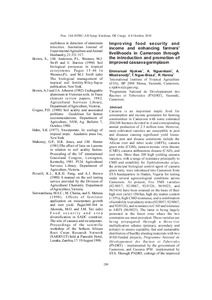| dc.contributor.author | Njukwe, E. |
| dc.contributor.author | Nguenkam, A. |
| dc.contributor.author | Mbairanodji, A. |
| dc.contributor.author | Ngue-Bissa, T. |
| dc.contributor.author | Hanna, R. |
| dc.date.accessioned | 2019-12-04T11:07:56Z |
| dc.date.available | 2019-12-04T11:07:56Z |
| dc.date.issued | 2012-02 |
| dc.identifier.citation | Njukwe, E., Nguenkam, A., Mbairanodji, A., Ngue-Bissa, T. & Hanna, R. (2012). Improving food security and income and enhancing farmers' livelihoods in Cameroon through the introduction and promotion of improved cassava germplasm. In: Proceedings of the 11th triennial Symposium of the ISTRC-AB held at Memling Hotel: Tropical roots and tuber crops and the challenges of globalization and climate changes, (pp. 289-295), Kinshasa, 4-8 October. Ibadan: International Association of Hydrological Sciences. |
| dc.identifier.uri | https://hdl.handle.net/20.500.12478/1658 |
| dc.description.abstract | Cassava is an important staple food for consumption and income generation for farming communities in Cameroon with some estimated 204,548 hectares devoted to it and corresponding annual production of 2.5 million tons. However, most cultivated varieties are susceptible to pest and diseases causing significant yield losses. Major pest and disease constraints include the
African root and tuber scale (ARTS), cassava green mite (CGM), cassava mosaic virus disease (CMD), cassava anthracnose disease (CAD), and root rots. More than 200 high yielding cassava varieties, with a range of resistance principally to CMD and suitability for Typhlodromalus aripo, the principal biological control agent of cassava green mite, were introduced into Cameroon from IITA headquarters in Ibadan, Nigeria for testing under several agroecological conditions across Cameroon. At present, five TMS varieties (92/0057, 92/0067, 92/0326, 96/0023, and 96/1414) have been retained on the basis of their high root yield (>20t/ha), high dry matter content (>35%), high CMD resistance, and a combination of suitability to predatory mites (92/0057, 92/0067, and 92/0326), and resistance to CAD and tolerance to ARTS (96/0023). The latter is being largely promoted in the forest zone where the two constraints are most prevalent. These varieties are being propagated through a three-tier multiplication scheme (primary, secondary and tertiary) to ensure equitable, fast and sustainable distribution of healthy planting materials with two IFAD-funded projects, Programme National de Développement des Racines et Tubercules
(PNDRT) - implemented by the government of Cameroon, and Cassava IPM implemented by IITA. Through PNDRT, cuttings of the improved varieties (92/0326 and 96/1414) were multiplied and distributed to farmers in 221 villages. The Cassava IPM project emphasized the multiplication and distribution of 96/0023 in the forest zone where ARTS and CAD are major constraints, and 92/0057, 92/0067 and 92/0326 for several regions in Cameroon due to their suitability to the biological control of cassava green mite, in addition to their resistance to CMD. At least 500 farmers in the targeted zones have grown at least 100 plants of each of the varieties in the targeted areas. Presently, more than 550 hectares have been set aside by both projects to produce planting material for distribution. These dissemination schemes have significantly boosted cassava production from 8-10 tons per hectare to 25-30 tons per hectare, and have provoked the need for post-harvest facilities. |
| dc.description.sponsorship | International Fund for Agricultural Development |
| dc.format.extent | 289-295 |
| dc.language.iso | en |
| dc.publisher | International Association of Hydrological Sciences |
| dc.subject | Cassava |
| dc.subject | Host Plant Resistance |
| dc.subject | Income Generation |
| dc.subject | Food Security |
| dc.subject | Livelihoods |
| dc.subject | Germplasm |
| dc.subject | Cassava Mosaic Virus Disease |
| dc.subject | Cassava Anthracnose Disease |
| dc.subject | Root Rots |
| dc.title | Improving food security and income and enhancing farmers' livelihoods in Cameroon through the introduction and promotion of improved cassava germplasm |
| dc.type | Conference Proceedings |
| cg.contributor.crp | Roots, Tubers and Bananas |
| cg.contributor.affiliation | International Institute of Tropical Agriculture |
| cg.contributor.affiliation | Programme National de Développement des Racines et Tubercules, Cameroon |
| cg.coverage.region | Africa |
| cg.coverage.region | Central Africa |
| cg.coverage.country | Cameroon |
| cg.authorship.types | CGIAR and developing country institute |
| cg.iitasubject | Cassava |
| cg.iitasubject | Livelihoods |
| cg.iitasubject | Pests Of Plants |
| cg.iitasubject | Plant Diseases |
| cg.howpublished | Formally Published |
| cg.publicationplace | Ibadan, Nigeria |
| cg.accessibilitystatus | Limited Access |
| local.dspaceid | 82799 |
| cg.targetaudience | Scientists |

